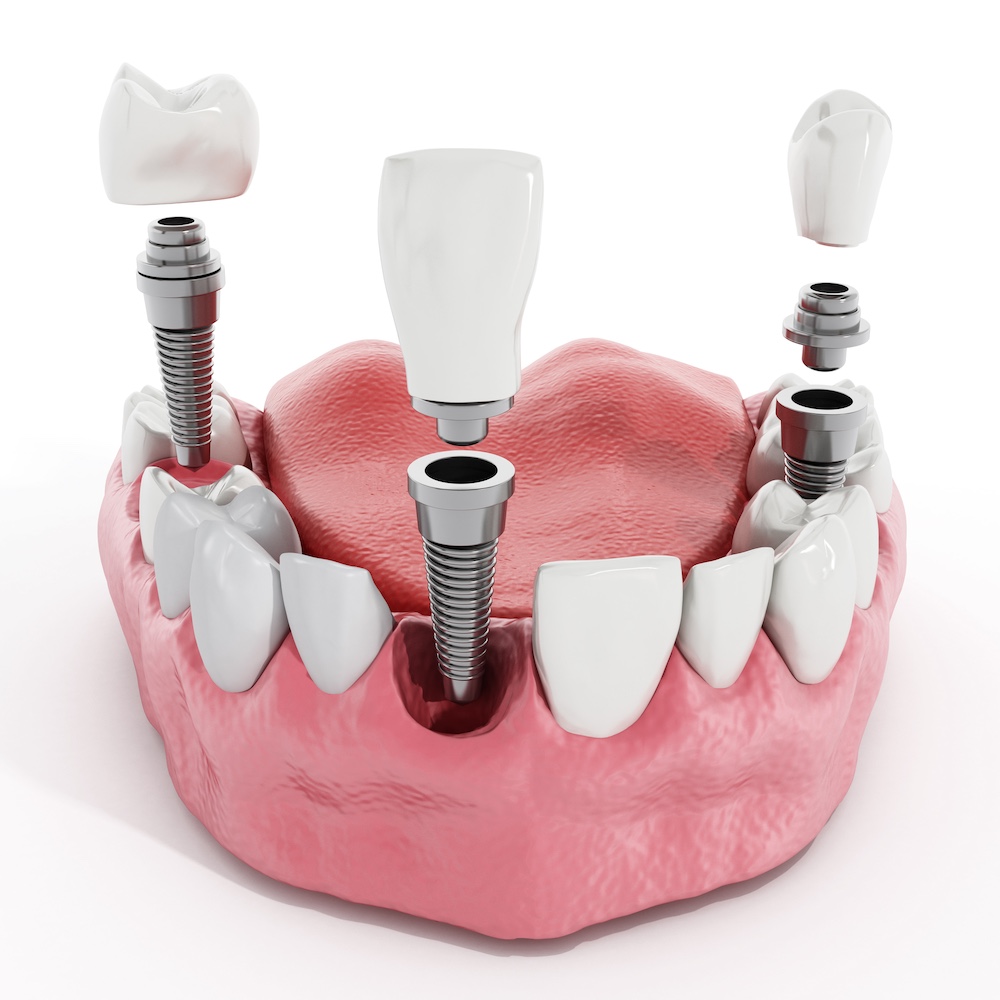Restorative dentistry is the practice of repairing or replacing teeth, with the primary goal being to improve oral health and chewing function—and in many cases, these procedures also improve an individual’s smile. Restorative dentistry is performed by general dentists and is ideal for patients with cavities, tooth decay, damaged or broken teeth, or missing teeth. It is often confused with cosmetic dentistry, which is focused exclusively on improving the appearance of the mouth and teeth. However, restorative dentistry aims to correct oral health issues for long-term oral health, with any improvement in appearance being a secondary benefit.
There are six primary restorative dental procedures:
- Fillings
- Crowns
- Bridges
- Implants
- Inlays & Onlays
- Dentures
In this article, we will explore the details of each restorative dentistry procedure and how each is performed.
Fillings
Bacteria eating away at tooth enamel can lead to a hole in the tooth, which is what we commonly call a cavity. Small cavities are routinely repaired with fillings, which is when a dentist removes the decayed part of the tooth with a dental drill and fills the hole with a composite material. This process stops the progression of further decay by sealing the tooth structure. The most common filling material is composite filling, which is tooth-colored and easily matched to other teeth so that they remain unnoticeable. It’s not uncommon for fillings to be replaced after many years of wear and tear, especially if proper oral hygiene isn’t followed or dense foods such as hard candies are consumed regularly.
Crowns
Dental crowns, sometimes referred to as “caps,” are protective enamel replacements used to repair large cavities, broken teeth, or otherwise compromised teeth. They fit over an existing tooth, with a dentist removing some natural tooth enamel through shaving before placing the crown. They are used to restore both the form and function of a tooth. Crowns are also common following a root canal to restore function and prevent future loss of the tooth. There are various types of crowns that leverage different materials, such as gold, porcelain, metal, and zirconia (aluminum base with porcelain on top), with all-porcelain crowns being the most common.
Bridges
A dental bridge replaces a single missing tooth or a row of missing teeth, bridging the gap between teeth. It is an artificial tooth with dental crowns on either side. To insert a dental bridge, a dentist must shave down the natural teeth on both sides of the gap, and then bond the bridge to the natural teeth. Abutments and pontics make up traditional dental bridges, with abutments serving as the connecting structures that support the dental bridge, and pontics being the artificial teeth filling the space left behind by the missing teeth. Beyond traditional bridges, there are cantilever dental bridges which involve a crown only on one end, a Maryland dental bridge that uses metal wings instead of crowns to secure the bridge, and an implant-supported bridge which is similar to a traditional bridge but rests on top of dental implants instead of natural teeth.
Implants

Dental implants involve the surgical insertion of a small, threaded titanium post into the jaw bone (similar to a screw) that serves as a replacement for a missing root. Once the area around the screw heals from surgery, a connector is added, then a crown is placed on top—which looks and feels just like a natural tooth. Unlike crowns and bridges detailed above, implants do not require shaving or any alteration of the natural surrounding teeth. Implants are a lengthy process, as each stage must be done separately to allow healing time. First is the surgical procedure to insert the screw, followed by a restorative stage of four to six months for healing before adding the crown. According to the American Academy of Dental Implants, these are extremely common, with more than 1 million people treated each year and another 150 million who are candidates due to missing at least one tooth.
Inlays & Onlays
In certain cases, a cavity is too large for a filling and too small for a crown, requiring an indirect filling. The two types of indirect fillings are inlays and onlays, and both are custom restorations that are permanently bonded into place. Inlays are very similar to fillings but focused within the cusps (bumps) on the tooth’s chewing surface. Onlays are more extensive than inlays, covering more than one cusp, and sometimes called “partial crowns.” These alternatives are often used when the patient doesn’t have enough tooth structure to support a filling, but the tooth is not damaged or decayed enough to warrant a crown. Inlays and onlays are very durable, lasting much longer than fillings—often up to 30 years.
Dentures
Dentures are a form of teeth replacement used when teeth cannot be restored through the less invasive processes detailed above. Full dentures replace an entire arch of teeth, and partial dentures replace several missing teeth. Traditional dentures are positioned on top of gums and are removable, but patients can also choose implant-supported dentures, which are permanent. Instead of resting on top of the gumlines, implant-supported dentures attach to dental implants and provide more stability. Dentures are made from plastic, metal, or porcelain, with the process performed by dentists or prosthodontists who specialize in dentures. Dentures are considered the last resort for tooth replacement since it involves oral surgery to remove multiple or all teeth. All other options to save teeth are exhausted before resorting to dentures. The ADA offers additional insight on dentures, including proper care following the procedure.

Restorative dentistry offers patients the best chance at long-term oral health, restoring a mouth to full function and fixing damaged teeth. Each option detailed above improves an individual’s ability to eat, speak, and chew, and eliminates chronic dental pain. While restorative dentistry differs from cosmetic dentistry, an improved and more confident smile is an added bonus to these procedures.
Contact us if you would like to learn more about restorative dentistry.
